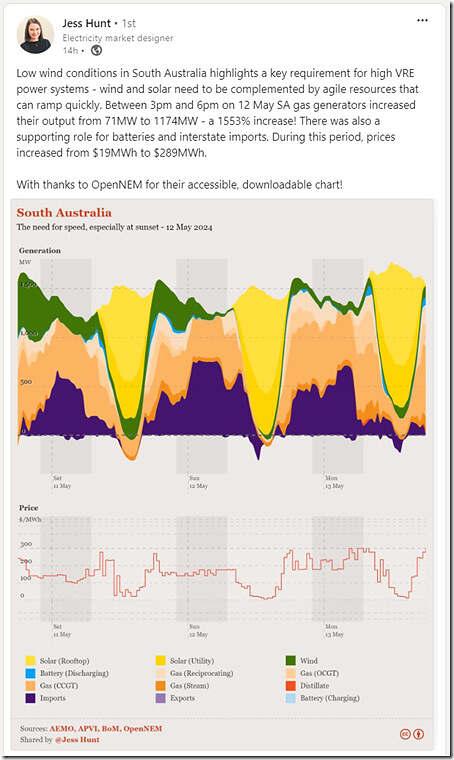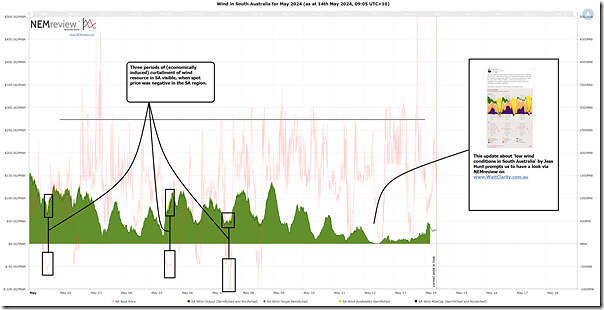Whilst speaking about social media posts, yesterday I also noticed this update by Jess Hunt about low wind conditions currently in South Australia.
Given we’re increasingly coming back to review these types of events (e.g. for GenInsights Quarterly Update for 2024 Q2) I thought it would be useful to record this here today.
There’s a few interesting comments in the conversation under Jess’ post (and perhaps more to come), so thought it useful to highlight two:
(A) Was there any curtailment of Wind?
Tim Ryan asks was there any curtailment of wind in South Australia over this period.
With quick reference to NEMreview v7 we can confirm that, at least in terms of those wind farms that are Semi-Scheduled, or operating with Semi-Scheduled requirements, there’s not been any noticeable curtailment of wind in the past few days in South Australia:
Those with their own licence to the software can open their own copy of this trend here.
I’ve highlighted on the chart three visible periods of curtailment earlier in the month. More broadly with respect to curtailment, worth reminding readers here that Dan Lee recently published ‘Keeping Up with the Curtailment Part 2: The what and the where’ to continue his series.
(B) Flexibility required
Also in the comments, Joel Gilmore notes this:
‘I think this is a great example of the value of flexible firming technologies. The corollary to me, though, is that we need to ditch inflexible. Going forward of course, all new resources will be at _least_ as flexible as gas – in the case of batteries or the demand side, even more so. (So we don’t need natural gas specifically – though, if transport and storage allows, it might be worth saving some emissions budget for this purpose.)’
With respect to this comment:
B1) Do we, or do we not, need gas peakers?
A note of caution, for those readers who might want to Joel’s note here that ‘we don’t need natural gas specifically ’ (given all the conniptions politically about the recent gas strategy) that Gilmore was co-author on this recent Simshauser/Gilmore Working Paper that (in my reading) highlights all five principles:
Principle 1) We’re likely to need a sizeable amount of peaking capacity that can burn gas:
(a) would be even better insurance if it was dual fuel, so could burn liquid fuels;
(b) even better if it could burn things that had net lower emissions.
Principle 2) On average, it won’t run that often:
(a) Low annual gas demand;
(b) And low aggregate emissions.
Principle 3) But on critical occasions (e.g. during long Dunkelflaute events that exhaust other stored energy) would need to contribute a large amount of megawatts.
Principle 4) Market (or other) arrangements need to be in place to ensure that the owners/operators of this type of peaking plant:
(a) Ensure the plant is built; and also
(b) Ensure the plant is properly maintained, and supplied with fuel, ready to go during these insurance events.
Principle 5) This is going to cost money, and that money needs to be added into the cost of :
Part of the challenge of managing the energy transition towards a VRE + Firming world (it seems to me) is reconciling oneself with all of the 5 principles above.
B2) A real ‘Statement of Opportunities’?
Back on 12th April 2022 we shared what we’d written sometime before as Observation 8/22 from GenInsights21–what is the purpose of the ESOO (Electricity Statement of Opportunities)?.
In those comments, we wondered how different the ESOO would look if it was to really be a genuinely focused ‘Summary of Commercial Opportunity’?
To my mind, such a document would separate out the two elements (i.e. VRE and Firming) and separately identify the opportunities for both.
With respect to the requirement for firming capacity, that’s what we have been doing for many quarters now with the metric ‘Aggregate Scheduled Target’ (i.e. a representation of what NEMDE is actually saying is required for firming assets each dispatch interval):
1) This is analysed in considerable detail each quarter in GenInsights Quarterly Updates;
2) With some snippets shared in WattClarity articles catalogued under ‘The Need for Firming Capacity’
… including, with respect to the requirement for flexibility, analysis about the ramp in AggSchedTarget over various timeframes.




Be the first to comment on "Low wind harvest in South Australia"